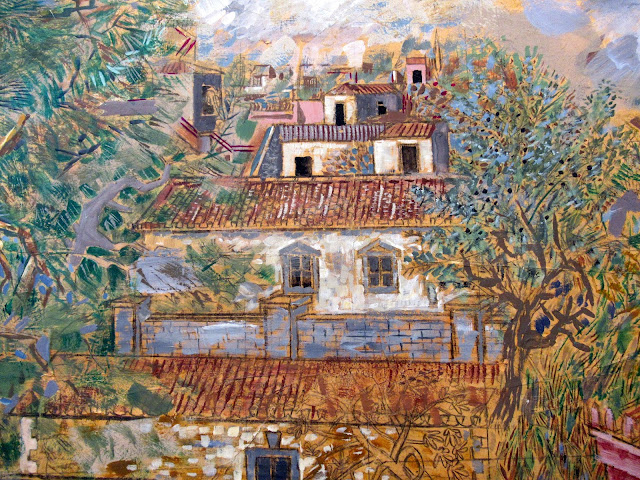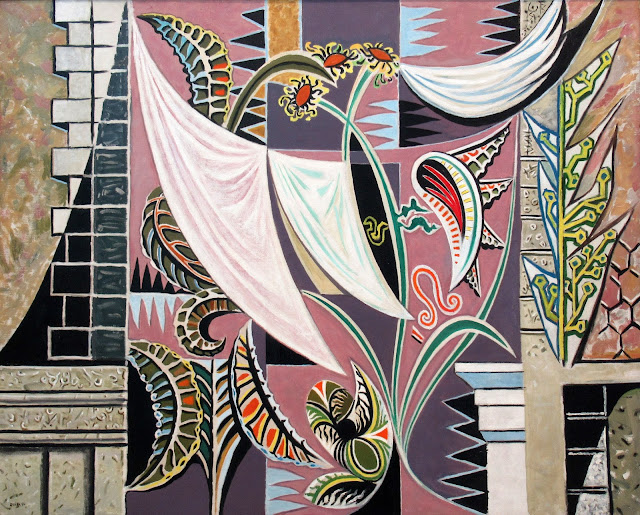Nikos Hadjikyriakos-Ghikas at the National Gallery, Athens.
Nikos Hadjikyriakos-Ghikas, also known as Niko Ghika, combined elements of European Cubism and traditional Greek art to create his own personal style.
A student of Konstantinos Parthenis in Athens, Ghikas left in 1922 for Paris, where he studied French Literature and Aesthetics at the Sorbonne, and Painting and Printmaking at Academie Ranson with teachers Bissiere and Galanis.
European modernism had already completed its consecutive revolutions through a series of movements that developed in various directions. The post-WWI optimism, the intellectual tolerance, the exuberant artistic ambience of Paris, defined the climate which had a formative influence on young Ghika. His teacher Konstantinos Parthenis had prepared him though his 'linear, geometric and methodical teaching' to understand Cubism and Geometric Abstraction without much effort. Furthermore, this contemplative and educated painter would soon discover the same principles in Byzantine art.
'In Paris, which was the foremost artistic center of the time', he said, 'I was spontaneously drawn to the most austere form of art, Cubism, or rather its second period, Synthetic Cubism'. While Analytical Cubism sought the reduction of the visible to conceptual shapes, Synthetic Cubism returned to their sources, to the senses, to a new acquaintance with the things themselves, which finally led to collage. Ghika was initiated to both these variants, through nature and through Greek light and colour.
Once he returned to Greece, Ghika discovered that this rejuvenated philosophy of Cubism had deep roots in medieval Greek painting: reversed perspectives; dismissal of the horizon line; economical use of colour; colour used emotionally rather than descriptively. These aesthetics are to be found in Byzantine art, in the mosaic of the city of Nazareth; in the church of Karye Tzami in Istanbul, for instance. What was dismissed in the 19th century as primitive, was now accepted as an escape from the tyranny of photographic representation. Painters were now free to find joy in transformation instead of being restricted by imitation. This was the freedom that Ghika reintroduced to his native country.
In his painting he focused on the harmony and purity of Greek art and attempted to deconstruct the Greek landscape and the intense natural light into simple geometric shapes and interlocking planes.
In addition to painting, Ghikas also worked creatively with sculpture, engraving, and book illustrations. He designed for the ballet and the theatre. He also wrote books, articles and studies on Architecture and Aesthetics, as well as essays on Greek art.
In 1949 he formed, with other artists including Yannis Moralis, Yannis Tsarouchis, Nikos Nikolaou, Nikos Engonopoulos and Panayioitis Tetsis, the Armos art group. In 1973 he became a member of the Athens Academy and in 1986 a member of the Royal Academy in London. He was also a member of the Tiberiana Academy in Rome. In 1988 he had his last exhibition at the Royal Academy in London. Today in Greece, he is celebrated as one of the most important modern Greek painters. His house has been converted to a museum.
In 2018, The British Museum hosted an exhibition which focused on the friendship of Ghika, John Craxton and Patrick Leigh Fermor; their shared love of Greece was fundamental to their work. You can read about this exhibition here
He died on 3 September 1994 in Athens.








































No comments:
Post a Comment